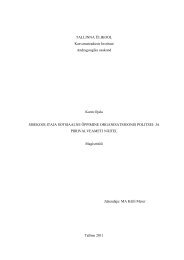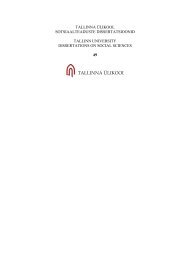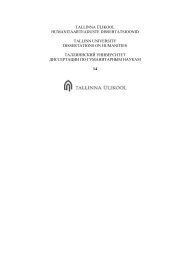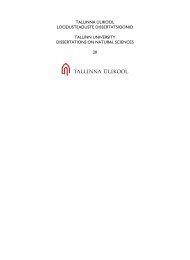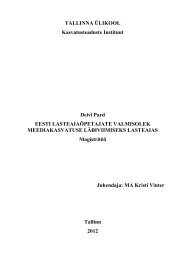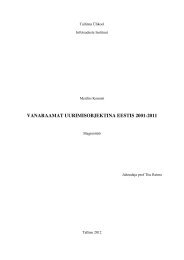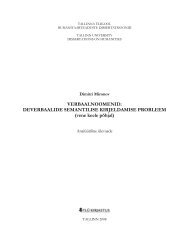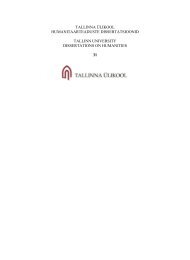Create successful ePaper yourself
Turn your PDF publications into a flip-book with our unique Google optimized e-Paper software.
probably familiar fields for the Uus-Pärnu elite. It must have been this, with high probability,which made in the early 16 th century the citizens oppose the idea of having a monastery of theirown in the town. Their familiarity with the subjects important and concerning the social andreligious life in the Christendom was an outcome of tight communication beyond Livonia. Ofgreatest importance in shaping the ideological convictions and enabling lively discussion anddispute were no doubt the universities. At the late Middle Ages merchants were more are morewilling to invest in education. There are data about many a merchant of Uus-Pärnu that hadattended a university. During the Early Modern Age the European cities gradually developed anew type of their elite characterized also by university education.The key social force of the Reformation in Livonia was its towns, to be more exact, theircitizens. The ideas of the new teaching were carried and spread first by a narrow circle ofintellectuals, primarily clergymen. The driving force of the Reformation in Uus-Pärnu was alsothe preacher disseminating the evangelical message. He was supported by the members of themerchants’ guild whose pressure appointed him into the employ of St. Nicholas church. Theattitudes and principles of merchants favoured saving and minimum taxes paid to the church,restrictions on squander and luxury, and the increase of the town revenue at the cost of thechurch. The consent by the majority of the Uus-Pärnu citizens was sufficient to secularize thechurch property. There were about 70 citizens in Uus-Pärnu. Thus the Reformation rested on avery thin but nevertheless the dominant class in the town. The 1525 secularization of the churchproperty did not mean the victory of the evangelical doctrine or of the Lutheran teaching. Thepurified Word of God and the “cheap” church in Uus-Pärnu was an outcome of the iconoclast.In other words the Reformation was achived only through a “ritual process”. The iconoclast ofUus-Pärnu was clearly an act of faith, the manifestation of the citizens as there was no propertyin the church anymore that could be stolen or dispersed. The altars, the pictures and statues ofsaints were smashed because in the light of the new doctrine these had lost their meaning. In theUus-Pärnu iconoclast there took part both the upper and the lower classes. The Reformation inLivonia was accompanied by various collisions. A sign of deepened social antagonism in Uus-Pärnu after the iconoclast was the resentment of the people turned against the town council.This conflict, however, was resolved quite quickly, with the Order in the role of the in-between.In 1530s–1540s the artisans of Uus-Pärnu were gradually ousted from more prestigious districtsof the town and the merchants moved their company from the so-called artisans’ quarters – thiscan be also seen as a sign of sharp social antagonism in the town. Confessional discords musthave been also present but these caused no implacable conflicts in Uus-Pärnu, at least there areno records of them. It is noteworthy that there was no clear confessional conflict with thepowers of the Order. This testifies to the changes in the branch of the Livonian Order and showsthat the members of the Order remained faithful to their old religion often only formally. TheReformation brought to an end the spiritual supremacy of the Order in Uus-Pärnu but the Order,however, preserved its authority in ecclesiastical matters.The Reformation made its changes in the corporate organization of the inhabitants of Uus-Pärnu. The church guilds were dispersed and this is what probably triggered the formation ofthe guild of the craftsmen. The secularization and the changes it brought along were revealed inthe statues of the guilds. There has been preserved the 1588 charter of the Uus-Pärnumerchants’ company that is totally void of religious elements. Prayers for the salvation of theirdeceased comrades were insignificant in the light of the new ideology and in comparison withthe teaching of the medieval church. The new ideology changed many rituals accompanying thelife of a citizen. It can be guessed that under the influence of secularization the religious serviceattached to the election procedure of the town council was now rather a ceremony of thanksgivingthan that asking for blessing for the successful election. First and foremost, however, theReformation in Uus-Pärnu changed its religious life and church organization. It meant first the233




